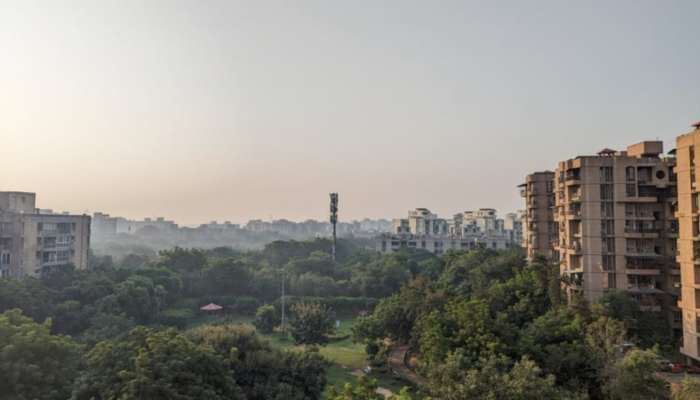
by Swamini Khurana
Air pollution in India, particularly in north India, is a long-standing problem (1,2) with reportedly 63% of Indians living in areas exceeding the WHO guidelines for PM2.5 levels of 40 µg/m3. This makes India one of the most polluted countries in the world (typically among the worst 5 countries over the past 4-5 years (3)), along with Pakistan and Bangladesh. In fact, this makes the Indian subcontinent the worst polluted region in the world.
The sources of air pollution in north India are numerous; the adjacent desert in the west contributes dust during the summer months, infrastructure projects contribute dust and particulate matter and poor fuel quality and high dependence on motorized transport contribute sulfur and nitrogen oxides, and soot all year! The problem significantly worsens in October and November.
This period marks a shift in the wind patterns in north India: south/south-western monsoonal winds from the Arabian Sea and the Indian Ocean are replaced by west/north-western winds originating in the Mediterranean Sea and west Asia (middle school Geography lesson to the rescue (4); check out this cool animation of global wind currents (5)). Thus, the air quality in north India is not only dependent on the anthropogenic activities at the location, but it also depends on the landscape and activities in locations upstream of the wind currents!
What does this have to do with groundwater management? Well a long long time ago, when there was a food security crisis in India (1970s), the Government of India (GoI) enabled the Green Revolution (6), led by M.S. Swaminathan. Among many factors that contributed to the success of this program, improving irrigation facilities was a key contributor especially since rainfall in India is concentrated within 2-3 months of the year. The northern state of Punjab, in fact, provided the farmers with subsidized electricity and fuel to abstract groundwater for irrigation during the winter and early summer seasons. This led to unexpected overexploitation of this precious resource and a significant drawdown of the water table (7), particularly for paddy cultivation (8).
In response to this, the states of Punjab and Haryana legislated in 2009 to delay the sowing of paddy seeds closer to the monsoon, so that farmers in the region abstract less groundwater for irrigation purposes (9). Consequently, this resulted in a delayed harvest of paddy (to late October/early November), leaving the farmers with little room to clear the fields in time for the winter crop. Running out of time and lacking machinery, farmers resorted to stubble burning (10) as a quick solution. Recall that this stubble burning now coincides with shifting wind patterns. These winds now carry the smoke and particulate matter across the plains of north India, essentially, tightening the noose around the neck of the rest of north India.

Caption: Stubble burning, Punjab, India, November 2020. Source: OpIndia
Some solutions being explored to address this issue more holistically include paddy varieties that require a shorter time to mature. This would allow farmers more time to clear the stubble without resorting to burning. Alternatively, promoting crops that require less irrigation over the summer months would reduce the pressure on groundwater resources. But, this may involve a more large-scale change in the diets of the population in the region. Another option could be to provide compensation to farmers so that they let go of paddy altogether. Enabling successful management of environmental resources (air quality and groundwater resources) and public health (food security, nutrition and air quality) is a demanding task for policy makers. A holistic approach could help balance the interests between air quality, irrigation rights, food security and agricultural economics. This requires the knowledge of experts in groundwater management, air quality, agriculture and economy, as well as the experience of on-the-ground social workers examining the situation of stakeholders.
1 Warning: Air quality in North India may turn ‘severe’ by Diwali (downtoearth.org.in) 2 Combatting air pollution in Northern India: Cooperative federalism is the way forward | ORF (orfonline.org) 3 World's Most Polluted Countries in 2021 - PM2.5 Ranking | IQAir 4 Chapter 4.pmd (ncert.nic.in) 5 earth :: a global map of wind, weather, and ocean conditions (nullschool.net) 6 Green Revolution (drishtiias.com) 7 Kaur, Samanpreet & Aggarwal, Rajan & Soni, Ashwani. (2011). Study of water-table behaviour for the Indian Punjab using GIS. Water science and technology : a journal of the International Association on Water Pollution Research. 63. 1574-81. 10.2166/wst.2011.212. 8 Punjab tops country in over-exploitation of groundwater : The Tribune India 9 Punjab and Haryana Groundwater Policy Choking Delhi-NCR (geospatialworld.net) 10 Punjab crosses the 10,000 mark of stubble burning by recording over 2,000 fires on Friday | Cities News,The Indian Express



